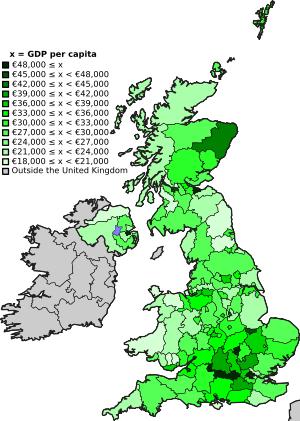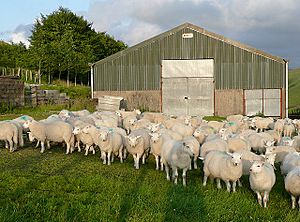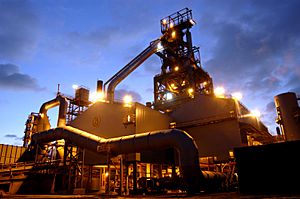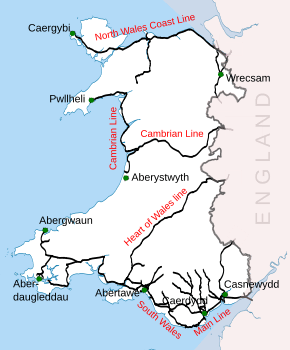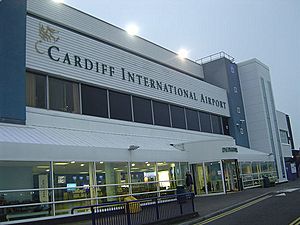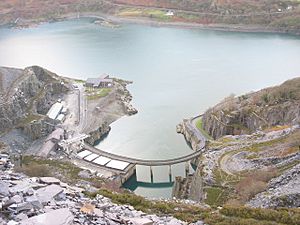Economy of Wales facts for kids
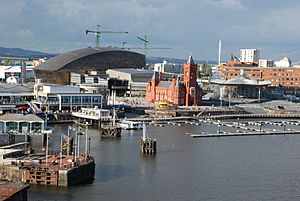
Cardiff: Wales's capital city
|
|
| Currency | Pound sterling (GBP) |
|---|---|
| Statistics | |
| GDP | |
|
GDP growth
|
|
|
GDP per capita
|
|
|
Population below poverty line
|
|
|
Labour force
|
|
| Unemployment | ▼3.9% (July 2021) |
|
Main industries
|
Agriculture, aerospace, construction, electronics, emergency services, food, forestry, manufacturing, oil and gas, renewable energy, services, textiles, tourism, transport |
| External | |
| Exports | (2019: £17.7 billion) |
|
Export goods
|
Aerospace systems, business and financial services, cereals, chemical products, dairy products, electricity, electronics, iron and steel, machinery, oil and gas, pharmaceuticals, plastics, renewable energy, road vehicles, textiles, timber, water |
|
Main export partners
|
Excluding the rest of the |
|
All values, unless otherwise stated, are in US dollars. |
|
The economy of Wales is mostly shaped by the UK Government. This means Wales cannot borrow money or issue bonds on its own. In 2017, some parts of West Wales and the Valleys had the lowest incomes in Northern Europe.
About 23% of people in Wales lived in relative poverty in 2016–17. This was similar to England (22%) but higher than Scotland and Northern Ireland. For many years, more than one in five people in Wales faced poverty.
However, things have been improving. In 2018, the total value of goods and services produced in Wales, called GDP, was £75 billion. This was a 3.3% increase from the year before. The GDP per person in Wales was £23,866 in 2018, also showing growth.
Contents
How Wales's Economy Works
The UK has big differences in wealth between its regions. For example, some areas in West Wales have much lower GDP per person compared to Inner-London West. There are 26 areas in the UK where the GDP per person is less than €20,000.
Many people in Wales live in these areas. About 1.4 million Welsh people (45% of the population) live in six such regions. These include places like the Isle of Anglesey and the South West Valleys.
Differences Across Wales
In recent years, areas like Cardiff and the coastal regions have seen more jobs. But industrial towns, especially in the South Wales Valleys, have seen a decline. This is because more people want to live in places with a good quality of life. Also, big cities are better for service businesses.
Earnings and job numbers vary a lot across Wales. They are generally higher in east Wales, especially in cities. However, they are lower in south west Wales and the Valleys. Places like Bridgend and Neath Port Talbot still have good earnings due to skilled manufacturing jobs.
Cardiff is a major economic hub. It benefits from being the capital city and having good connections to London. Cardiff is a key place for service jobs in Wales. North east Wales also benefits from being close to big English cities like Manchester.
Many parts of Wales suffered when heavy industries like coal mining closed down. This led to high unemployment. Even though unemployment has gone down, many people in West Wales and the Valleys are still not working. This is often due to long-term illness or disability.
The table below shows the total value of goods and services (GDP) and GDP per person for different regions in Wales in 2016.
| Regions (NUTS3) | GDP € (2016) | GDP per capita € (2016) |
|---|---|---|
| Isle of Anglesey | ||
| Gwynedd | ||
| Conwy & Denbighshire | ||
| South West Wales | ||
| Central Valleys | ||
| Gwent Valleys | ||
| Bridgend & Neath Port Talbot | ||
| Swansea | ||
| Monmouthshire & Newport | ||
| Cardiff & Vale of Glamorgan | ||
| Flintshire & Wrexham | ||
| Powys | ||
| TOTAL | €81.683 bn | €26,200 |
In 2016, the GDP per person for Wales was €26,200. This was about 84% of the average for the European Union. The Cardiff and Vale of Glamorgan region had the highest GDP per person in Wales. The Isle of Anglesey had the lowest.
Key Parts of the Welsh Economy
Farming and Forests
In 2003, farming added £418 million to Wales's economy. This was about 1.1% of the total. Most of Wales's land (77%) is used for farming. Around 57,500 people work in this area.
Farming in Wales mainly focuses on beef, sheep, and dairy products. Only 10% of farming is for crops. Most farms are small, family-run businesses.
Forests and woodlands cover 14% of Wales. About 4,000 jobs are linked to forestry. The Welsh fishing industry is the smallest in the UK. This is partly because it's far from major distribution networks.
Making Things (Manufacturing)
Wales has many different types of manufacturing. Heavy industry, which used to be very important, has mostly declined. But metal refining is still a long-standing industry. For example, the Port Talbot Steelworks is a major steel plant.
Milford Haven has two oil refineries. They produce about a fifth of the UK's oil. Wales also makes many car parts. Ford has a big engine plant in Bridgend.
A company called Timet in Swansea makes titanium. This metal is used for jet engine blades and medical tools. In the 1980s and 90s, the electronics industry grew a lot in Wales. Many companies from North America and Japan set up factories here.
Who Wales Trades With
Wales trades a lot with other countries. The European Union and the United States are the biggest buyers of Welsh goods. Wales is part of the UK and EU single market, which means free trade with other EU countries.
Recently, Wales has also started trading more with fast-growing countries. These include China, the UAE, and Singapore. These countries are now among the top destinations for Welsh exports.
| Destination | Value | ||||||
|---|---|---|---|---|---|---|---|
| Source: Welsh exports: Fourth quarter 2015 | |||||||
In 2015, the total value of goods Wales exported was £12.2 billion. The top exports included power generating machinery, petroleum products, and iron and steel.
Services Sector
The service sector in Wales has grown well recently. However, it is still smaller than in most other parts of the UK. Many jobs in Wales are in public administration, health, and education.
Wales has fewer jobs in high-value services like finance and business services. This is partly because Welsh towns and cities are smaller than some other UK regions.
Tourism in Wales
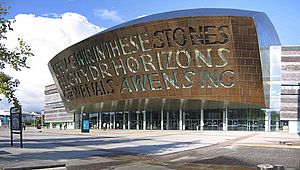
Wales is a popular place for tourism. It has mountains and many sandy beaches. In 2002, almost 13 million trips were made to Wales, bringing in £1.8 billion. Most of these visitors were from the UK.
Cardiff is the most popular place for visitors. In 2006, 11.7 million people visited the capital city. In 2014, over 10 million domestic trips were made to Wales.
| Attraction | Number of Visitors | ||||||
|---|---|---|---|---|---|---|---|
| Wales Millennium Centre | |||||||
| The LC | |||||||
| St Fagans National History Museum | |||||||
| Folly Farm Adventure Park and Zoo | |||||||
| Cyfarthfa Castle Museum | |||||||
| National Museum Cardiff | |||||||
| Pembrey Country Park | |||||||
| Elan Valley Visitor Centre | 400,000 | ||||||
| Snowdon Summit Visitor Centre | 393,432 | ||||||
| Cardiff Castle | |||||||
| Source: Visits to Tourist Attractions in Wales 2014 | |||||||
Property Market
In November 2008, the average house price in Wales was £126,181. This was a drop of 11.7% from the year before. House prices varied across Wales. For example, in August 2008, they ranged from £109,000 in Blaenau Gwent to £238,000 in Monmouthshire.
Transport and Energy in Wales
Getting Around (Transport)
Wales has a unique rail system. To travel from the capital, Cardiff, to the far north, you often have to go through England. Most train lines run east to west, not north to south.
Many major English cities have direct train links to Wales. The South Wales Main Line connects the south coast to England. An urban rail network serves 81 stations around Cardiff.
Roads
Major roads like the M4 motorway in the south and the A55 in the north are part of a larger European road network. These roads help connect Wales to the rest of the UK and beyond.
Ports
Wales has ten main commercial ports. Milford Haven is the UK's largest energy port. It can handle 30% of the UK's gas needs. Newport is the busiest UK port for iron and steel.
Airports
Cardiff Airport is the only Welsh airport with regular international flights. Anglesey Airport also became a public airport in 2007.
Energy and Utilities
Wales produces more electricity than it uses. In 2018, Wales generated twice as much electricity as it consumed. This means it exports electricity to England, Ireland, and Europe.
In 2018, 25% of Wales's electricity came from renewable sources like wind and hydro power. The Welsh Government wants 70% of Wales's electricity to come from renewable sources by 2030. In 2021, over half of Wales's energy needs were met by renewable sources.
Images for kids
See also
 In Spanish: Economía de Gales para niños
In Spanish: Economía de Gales para niños


